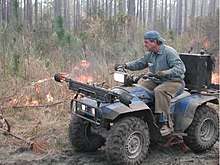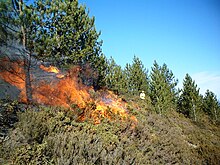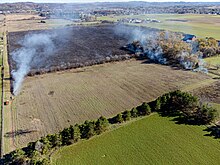
Back حرق محكوم Arabic Контролиран пожар Bulgarian Crema controlada Catalan Vypalování porostů Czech Kontrolliertes Abbrennen German Αντιπύρ Greek Fajra senveprigo Esperanto Quema prescrita Spanish آتشسوزی مصنوعی مهارشده Persian Kulotus Finnish





A controlled or prescribed (Rx) burn is the practice of intentionally setting a fire to change the assemblage of vegetation and decaying material in a landscape. The purpose could be for forest management, ecological restoration, land clearing or wildfire fuel management. A controlled burn may also refer to the intentional burning of slash and fuels through burn piles.[1] Controlled burns may also be referred to as hazard reduction burning,[2] backfire, swailing or a burn-off.[3] In industrialized countries, controlled burning regulations and permits are usually overseen by fire control authorities.
Controlled burns are conducted during the cooler months to reduce fuel buildup and decrease the likelihood of more dangerous, hotter fires.[4] Controlled burning stimulates the germination of some trees and reveals soil mineral layers which increases seedling vitality.[5] In grasslands, controlled burns shift the species assemblage to primarily native grassland species.[6] Some seeds, such as those of lodgepole pine, sequoia and many chaparral shrubs are pyriscent, meaning heat from fire causes the cone or woody husk to open and disperse seeds.[7]
Fire is a natural part of both forest and grassland ecology and has been used by indigenous people across the world for millennia to promote biodiversity and cultivate wild crops.[8] Colonial law in North America and Australia displaced indigenous people from lands that were controlled with fire and prohibited from conducting traditional controlled burns.[9] After wildfires began increasing in scale and intensity in the 20th century, fire control authorities in began reintroducing controlled burns and indigenous leadership into land management.[10][11]
- ^ "Managing Brush Fires" (PDF). February 2017.
- ^ "What is Hazard Reduction". www.hillside.rfsa.org.au. Archived from the original on 2019-10-09. Retrieved 2009-03-10.
- ^ Gage, Nicola (25 August 2016). "Burn-off rule change upsets Adelaide Hills residents". ABC News.
- ^ Guidelines for Low Intensity Bushfire Hazard Reduction Burning Archived 2019-03-12 at the Wayback Machine Retrieved on 11-3-2009
- ^ Cite error: The named reference
:7was invoked but never defined (see the help page). - ^ Cite error: The named reference
:3was invoked but never defined (see the help page). - ^ Cite error: The named reference
:8was invoked but never defined (see the help page). - ^ Cite error: The named reference
:9was invoked but never defined (see the help page). - ^ Fahnestock, George R. (1986-07-01). "History of Forest and Prairie Fire Control Policy in Alberta. By Peter J. Murphy. (Edmonton: Alberta Energy and Natural Resources, 1985. xiii + 408 pp. Illustrations, maps, bibliography, appendix, index. Paper $15.00 Canadian.)". Journal of Forest History. 30 (3): 139. doi:10.2307/4004885. ISSN 0094-5080. JSTOR 4004885.
- ^ Cite error: The named reference
:10was invoked but never defined (see the help page). - ^ Cite error: The named reference
:11was invoked but never defined (see the help page).
© MMXXIII Rich X Search. We shall prevail. All rights reserved. Rich X Search